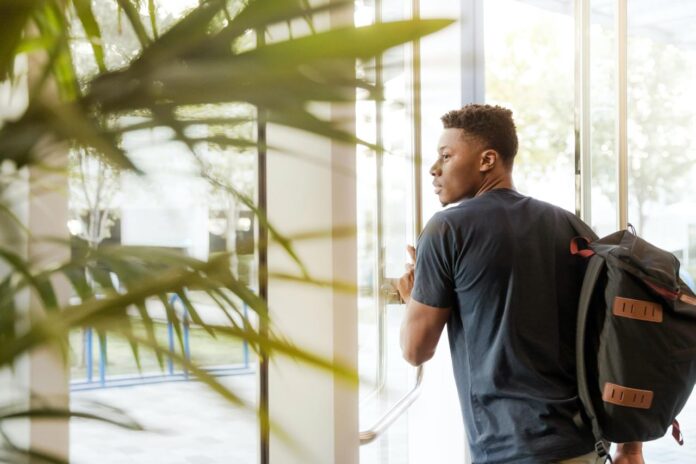Everyone in the packed room in the student center was in tears. What started as a classic, routine “Meet the Greeks” educational program for undergraduate college students interested in Divine Nine[1] (D9) organizations, soon took a drastic turn from the norm. The unorthodox shift in protocol broke the unwritten rules for Meet the Greeks presentations. The young D9 member, who just joined his fraternity last semester, stood in front of the room, commanding the audience like an old Southern minister three times his age. His emotionally filled family story on what motivated him to join his fraternity sounded more like something one watches during a Hallmark holiday television special. As he began to sit, gently placing the wireless microphone down on the long table where each of the other D9 chapter representatives was sitting in the front of the audience, the room remained silent.
Garnering the confidence and presence to share something so personal that he and his family survived is both unusual and courageous. He said he first learned about his Black Greek fraternity when he and his mother were served food by them while living in a homeless shelter as a child. By the time he attended college, his whole perspective of what service and support looked like was shaped by those interactions. He immediately sought out that same fraternity on campus to be a part of what helped him become who he is today.
Is everyone’s journey into membership as riveting, motivational, and inspiring as what this young man courageously shared? Probably not.
While everyone’s story is different, it wasn’t just what he was saying, but how he was saying it. The young man’s personal presentation and personal family context are a stark contrast to the normal rote responses in a traditional Meet the Greeks. Usually, members, one after another like robots, read verbatim the chapter’s founding date, the organization’s founding date, the programs they completed, and sometimes, if the audience is lucky, what they need to do to join.
Is that information important? Of course, it is. But that same information can often be found on websites and social media. What can’t be found on websites and social media is the “why?” – Why did you join?
Students are not joining a national website or a chapter Instagram (IG) page, they are joining you. Ultimately, facts tell, and stories sell.[2]
It was at that moment I realized there are things campus-based professionals, chapter advisors, staff, regional/national leadership, undergraduate leadership, researchers, trainers, speakers, and consultants can do to better support not just D9, but all culturally based fraternal organizations (CBFOs)[3]. No longer can we pass things on as “tradition” without challenging their efficacy, efficiency, and impact. As someone who, over the last ten years, has spoken at over 300 different colleges and universities; at 100 conferences on CBFO experiences and concerns; and currently serves CBFOs by practicing fraternal law as an attorney, here are things I see that are currently working — and things that are not.
I focus this article on Black Greek Letter Organizations and trends that are effective in increasing engagement through programming like Meet The Greeks.
“Meet The Greeks… Like This?”
Call it NPHC 101, Greek Connect, or the half dozen other names that campuses across the country call this educational experience. Whatever the name, the premise is the same: We need to revamp the structure, flow, and purpose of what is being presented to the campus. Not many will argue against the fact that post-Covid, irrespective of the region, institution type, or D9 org, chapter numbers are down. Sure, some schools have had large membership intakes with fascinating Watch The Yard[4] new member presentations, but for the majority of the over 500 undergraduate institutions that have at least one D9 chapter, this is more the exception than the norm (NSSE, 2021). For example, undergraduate members of NPHC, as well as their organizational advisors, at a state flagship institution in the Midwest shared with us that they are still feeling the effects of Covid this semester due to a continued lack of in-person engagement caused by the pandemic (The Harbor Institute, focus group, November 2022).
The fundamental premise of Meet The Greeks is still relevant: increase engagement, awareness, and excitement around D9 organizations. Chapter and council expectations, program logistics, and marketing of this event (or lack thereof), however, can lead to more harm than good. To navigate these unintended potholes on the road to D9 success, I encourage you to try the following things.[5]
No “Greeks” Allowed + So You Want to Be Greek?
Asking students if they have questions while D9 members are present in the same space is like asking you and your significant other to disclose whether you are romantically intimate in front of your parents. It is awkward, uncomfortable, and unsettling.
The mere fear of D9 members’ presence combined with prospective members’ anxiety is enough to have a chilling effect on any room. This chilling effect is far from conducive to a supportive learning environment. I have attended funerals that have more joy, celebration, and empathy than some D9 Meet The Greeks programs I experienced.
Imagine investing an entire 60-120 minutes of your life, and all the students’ lives, for that matter, into an educational experience that is supposed to stimulate healthy dialogue and exchange. Conversely, you end up in a room where nothing is being said at all. What’s worse, things said, particularly by undergraduate D9 members who frequently give advice like, “Do Your Research,” can come across as cold, inauthentic, and distant. In those instances, I almost wish nothing had been said at all. Adding fuel to the fire, cancel culture, beyond social media, negatively impacts our communities by discouraging authentic dialog (Jabbari et al., 2022). These experiences are very real for Generation Z, as well as Generation Alpha, the generation currently following them (Pinsker, 2020).
So why are we continuing to allow this? Is this tradition or trash? Let’s start by changing the participant dynamic. Strategically separate D9 members and prospective members to cultivate more free flowing dialogue.
Separate AND Equal – Brown and Not Bored Education
After D9 members introduce themselves, along with their chapters, and the guest speaker finishes presenting, split the program into a separate session exclusively for interested members to ask questions. Logistically, we found this to be very helpful for students who have limited time to attend the main session. Additionally, find a smaller room, ideally in a different location from the main program room that creates a more intimate and relaxed environment. Even without D9 members present, hundreds of students can seem intimidating to others Additionally, a smaller setting allows students to personally opt in, which is much more conducive to asking and answering personal questions in a supportive environment.
Kiera Martin, director of FSL at the University of Louisville (UL), utilized this approach last year for her Meet The Greeks and experienced much success. “I have found that splitting conversation up to allow the students to talk freely and ask the questions to the Greek advisor and Rasheed allowed the students to feel comfortable and confident to go on to join the organizations that they wanted to join… when Rasheed came to our campus there were four men in our breakout session — all four of those men are now members of fraternities within the Divine Nine!”[6] In this instance, Kiera is a member of a D9 sorority, so I think it also brought a great balance to the session as well. Having both a seasoned member of a D9 fraternity and sorority, a campus-based professional on campus, as well as an external facilitator, presents a nice balance that creates an opportunity for students of color to see themselves in a place and space that is supportive.[7]
I also think the optional post-session is very helpful for students to put a face to a name for their FSL or student activity staff. For example, in the UL example, I remember Ms. Martin offered her contact info, where her office is physically located, and a personal invitation for students to reach out to when they needed her. This supports research that states Generation Z prefers, “in-person communication over all other available modes” (Bird, 2022).
The Million-Dollar Question – How much does it cost?
Who made the unwritten rule that sharing D9 membership costs at Meet The Greeks organization is not discrete?
In my experience, D9 students will fight you to their grave to protect this unwritten rule. One way to overcome this challenge is to meet in the middle on a range to join. For example, if there are five of the Devine Nine chapters active on your campus, ask what the lowest and highest cost is for membership fees. Then, agree that D9 participants will state that membership cost range, for example, from $1,500-$5,000, depending on the organization. This information is important since 1/3 of all college students are first-generation students of color (Schuyler, et al., 2021). Moreover, 92% of full-time, full-year Black undergraduate students receive some type of financial aid (NCES, 2010). Providing important information like membership costs empowers interested students to help them better understand and plan and budget for the financial obligations necessary to join.
On the Same Page
To increase engagement, it is important for each of the active D9 organizations to list out the entire Greek name on the advertisement for this program. In my experience, there are some Black undergraduate students who don’t know what NPHC stands for, means, or represents. A way to overcome any potential educational gaps is to list all the active D9 chapters on campus along with their three Greek letters and nicknames, if possible.
Standardizing your D9 language creates a shared understanding through shared language. This increases the chances of recognition and interest by providing at least one of three ways that students can identify D9 organizations, either by name, nickname, or through Greek letters. This shared language not only builds collective understanding in the campus community but also advocates collective branding. By utilizing this approach, we encourage each active organization to post the same flyer so each chapter has uniform communication with the same marketing material as opposed to different chapters utilizing their own version of the same event. This strategy is important because interested students in one D9 org may not follow that of another, especially if it is a different gender org. All active D9 organizations sharing the same post, with the same flyer, ideally at the same time, can more comprehensively increase participation.
Also, utilize some type of app or software, even something as simple as Google Forms, to capture feedback from Meet The Greeks. The participants’ contact information, including name, classification, hometown, GPA, and major, builds a D9 database for your campus. This D9 database serves as an excellent resource to personally invite students, staff, and faculty to future D9 events, along with, of course, thanking them for attending Meet the Greeks.
Overall, effective support for CBFOs ultimately resides in rethinking how one utilizes traditional programming platforms to engage, excite and ignite the community. Adapting more intentional and impactful best practices such as personal storytelling, intimate and inclusive spaces for further participant informational exploration, membership costs, and collective D9 branding can increase awareness, understanding, and interest in your campus and community.
References
Bird, M. (2022, June 10). Commentary: Gen Z employees are not “going back” to the office. they are discovering it. Fortune. https://fortune.com/2022/06/09/gen-z-employees-millenials-back-to-office-discovering-generational-gap-mentoring-leadership-success-martha-bird/
Cromwell , R. A., & Pualwan, E. N. (2022). The Harbor Institute Guide to Culturally Based Fraternal Organizations, 2nd Edition.
Hansen, D. J. (2022, November 4). Diversity and representation in higher education. HigherEdJobs. https://www.higheredjobs.com/articles/articleDisplay.cfm?ID=3243
Jabbari, J., Ferris, D., Frank, T., Malik, S., & Bessaha, M. (2022). Intersecting race and gender across hardships and mental health during COVID-19: A moderated-mediation model of graduate students at Two universities. Race and Social Problems. https://doi.org/10.1007/s12552-022-09379-y
McCrindle, Mark; Wolfinger, Emily (2009). The ABC of XYZ: Understanding the Global Generations (1st ed.). Australia. pp. 199–212. ISBN 978-1-74223-035-1 (Academic)
National Center for Education Statistics (NCES). (2010, July). Status and trends in the education of racial and ethnic minorities. https://nces.ed.gov/pubs2010/2010015/indicator6_25.asp#:~:text=Ninety%2Dtwo%20percent%20of%20full,or%20two%20or%20more%20races
National Pan-Hellenic Council. (2023, May 10). https://www.nphchq.com/
NSSE (National Survey of Student Engagement). (2021). Pandemic & student engagement. Evidence-Based Improvement in Higher Education. https://nsse.indiana.edu/research/annual-results/2021/story1.html
Pinsker, J. (2020, February 21). Oh no, they’ve come up with another generation label. The Atlantic. https://www.theatlantic.com/family/archive/2020/02/generation-after-gen-z-named-alpha/606862/
Schuyler, Sophie W.; Childs, Jonique R.; and Poynton, Timothy A. (2021) “Promoting Success for FirstGeneration Students of Color: The Importance of Academic, Transitional Adjustment, and Mental Health Supports,” Journal of College Access: Vol. 6: Iss. 1, Article 4. Available at: https://scholarworks.wmich.edu/jca/vol6/iss1/4
About the author
Rasheed Ali Cromwell, Esq. utilizes his unique experiences as a practicing attorney, former federal law clerk, educational consultant, national fraternity member, and speaker/trainer to address culturally-based fraternal organizations in a multi-disciplinary and holistic way.
He has presented at over 300 colleges/universities and organizations, in 45 states and has presented and represented over 25 different fraternal organizations belonging to IFC, NAPA, NMGC, NPC and NPHC at a national level regarding issues of diversity, equity and inclusion (DEI), risk prevention, leadership development, and fraternal law. Currently, he serves as the President of the Harbor Institute and serves as of counsel for the Fraternity Sorority Legal Group (FSLG). He is a financially active member of Omega Psi Phi Fraternity, Inc. and volunteers as legal counsel for the Washington, DC. Alumni chapter of the National Pan Hellenic Council (NPHC).
Follow him at IG @theharborinstitute or Twitter @harborinstitute.
[1] The Divine Nine is a commonly used term to describe all nine Black Greek Fraternities and Sororities (also known as Black Greek Letter Organizations (BGLOs)) who are a part of the National Pan-Hellenic Council (NPHC). NPHC is the umbrella organization that supports these organizations at an undergraduate, regional, and National level (National Pan-Hellenic Council, 2023).
[2] I am mindful that some CBFOs have strict policies and procedures as it relates to the “dos and don’ts” of new membership. This in no way is written to undermine or circumvent this protocol. It is merely an attempt to share personal stories that motivated them to join their organizations.
[3] CBFOs are fraternities or sororities that were founded for the primary purpose of advancing a marginalized community. In the fraternal world, these marginalized communities are often associated with supporting underrepresented populations who formed organizations to address the many challenges that their embers faced on a college or university campus (Cromwell and Pualwan, 2022).
[4] Watch The Yard is a “Black Greekdom’s Digital Yardshow” that currently has close to a half a million followers on Instagram.
[5] Again, for this Meet The Greeks example I am referring to D9 but it can be expanded to all CBFOs. Many of the concepts are transferrable to Asian, Latinx or Multicultural fraternities and sororities. For example, Meet the Greeks can be expanded to what some schools refer to as Multicultural Greek Council (MGC) exclusively or combined with NPHC.
[6] All four young men joined Alpha Phi Alpha Fraternity, Inc. The author of this article and speaker at the event is a financially active member of Omega Psi Phi Fraternity, Inc.
[7] “A major reason for representation is that when students see themselves in the faculty and course materials, they are more likely to see themselves as having a career in the field” (Hansen, 2022). This concept, in an academic and social context, is the premise for this nexus as it relates to membership in CBFOs.



